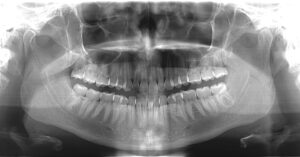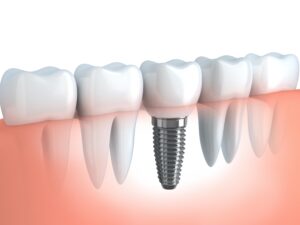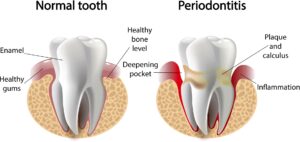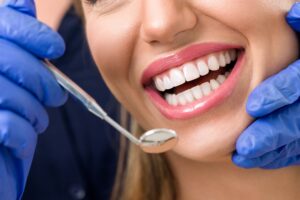Header logo
header top contact widget
Periodontist
Replace Teeth With Dental Implants Makes Good Sense
Posted on Nov 16, 2021 by William J. Claiborne, DDS MS
There’s a reason your general dentist is so determined to help you keep your natural teeth. When he or she recommends a crown (‘cap’) on a tooth to prevent potential removal (at the time or in the future), it is because a lost tooth is problematic in many ways.
First, the portions of teeth you see above the gum line stay in stable position because of the roots that hold it. Tooth roots (think “legs”) are supported by the upper or lower jaw bone. Larger teeth may have four roots. Some of the smaller teeth have only one.
These roots are beneficial to the health of the jaw bones. Tooth roots are connected to the jaw bone by veins and nerves that run from the tooth’s interior and out the bottom of each root leg. These vessels carry blood to the bone while providing a sort of stimulation that helps the bone to maintain its mass.
Think of the stimulation that tooth roots provide to how you might muscle atrophy. We all know that muscles, not used, will shrink in mass. When the jaw bones are lacking stimulation by the tooth roots they’re designed to hold, bone mass begins to decline.
Bone loss is the reason for a long line of problems. When bone loss occurs next to an area where natural teeth are held, those teeth are most likely to be the next to be lost.
When bone loss begins, it accelerates with each passing year. And eventually, a shrinking jaw bone reveals itself in changes in facial appearance. Initially, there may be deep wrinkling around the mouth. The corners of the mouth turn downward. Jowls form and the chin becomes more pointed.
As bone loss becomes more severe, the mouth seems to sink into the face. The nose and chin get closer, giving a “granny look”. The thin jaw bone is also more vulnerable to breaks.
Bone loss is what causes a change in how partials and dentures fit. As the bone height declines, the denture or partial becomes less secure from the declining bone shape to which it was designed to fit. More-frequent applications of pastes and adhesives are needed. Relines help but only temporarily.
Teeth also serve to support neighboring teeth. Each tooth keeps the ones on either side and above (or below) in proper position. This supports the “bite” alignment. A misaligned bite (how upper teeth fit and interact with lower teeth) can result in teeth that become chipped, worn or fractured.
Bite misalignment can also lead to TMJ disorder. The TMJ are your jaw joints, which hinge the lower jaw to the skull. When a misaligned bite causes stress or strain on these joints, the result can be headaches, sore jaw joints, ear ringing, vertigo, difficulty opening the mouth fully, and sore muscles in the face, neck and shoulders.
The reason we advise replacing teeth with dental implants are many:
1). A dental implant recreates the presence of a natural tooth. It provides stimulation to the bone, halting the process of bone loss.
2). Dental implants do not rely on neighboring teeth for support, as in a crown-&-bridge combination. The crowning of bordering natural teeth to support a bridge is not needed. Thus, the integrity of surrounding teeth is protected.
3). Because dental implants are supported by the jaw bone, sturdy and dependable biting and chewing strength is restored. Eating a healthy diet of all the foods you love is again possible.
4). Dental implants come in many sizes and shapes, each system designed to accommodate various needs and preferences. This means your implant can be chosen to suit your long-term goals.
5). Dental implants have an extremely high success rate, higher than any implant-in-bone option.
6). Dental implants are designed to last a lifetime. With proper selection and maintenance, they will never need replacing or repair. This makes them an excellent investment.
A periodontist is a dental specialist who is skilled offers an advanced understanding when it comes to oral tissues as well as dental implants. The advantages of a periodontist in dental implant selection and placement are many.
A periodontal specialist is trained to understand the intricate concepts involved in selecting the proper type of implant and skilled at placing implants at proper depths and angles. A periodontist is also able to optimize patient comfort during treatment and throughout the healing phase.
Using his or her advanced training in the diagnosis and placement of dental implants, a periodontist can help you enjoy a higher potential for dental implant treatment that lasts a lifetime.
In our Asheville periodontal dental office, we offer some of the most advanced technology available. This technology, combined with our advanced skill level, can help you enjoy a comfortable, efficient experience that allows you to have optimal success.
To learn more, call our office at: 828-274-9440 to request a consultation. Or, begin with an initial periodontal examination.
Mouth Sores – What Is Harmless & What To Watch Closely
Posted on Nov 04, 2021 by William J. Claiborne, DDS MS
As the holiday season approaches, our risk for illness goes up. Our chances for picking up colds or the flu increases, which is worrisome on its own. Add that to already-high concerns surrounding exposure to COVID, and we’re all taking added precautions to protect our health.
As in any year, colder months mean we’re more confined to the indoors and in closer proximity to others. With heightened potential for illness, the holidays simply create more stress to our lives. Stress is a contributor to our health as it compromises the immune system. This, in turn, lowers our resistance to fight off illness.
After the holiday mingling constraints endured in 2020, people are trying to take added precautions in 2021 so our “togetherness” is not overshadowed with worries about exposure to illness. To bolster our resistance, many people have had their Covid booster and flu vaccines, practice frequent hand washing, take vitamin supplements such as C, and are trying to stay active physically inside and out-of-doors.
Certainly, we applaud the health safety efforts taken by our Northwest NC population. As an Asheville periodontist, just a added tip for your overall health and well-being: Don’t forget to monitor the inside of your mouth while being committed to the other health measures you’re taking. You may be surprised at what your mouth reveals.
In busy times of year like the holiday season, we see a greater number of individuals who develop canker and cold sores. As stress goes up, your likelihood of getting a cold or canker sore increases as well.
The difference between Canker and Cold sores is:
Canker Sores
These are small ulcers that typically have a white or gray base and red border. Unlike cold sores, canker sores appear inside the mouth and are not contagious. The exact cause of canker sores is uncertain but fatigue, stress or allergies can increase the likelihood of a canker sore. Some experts suspect immune system problems, bacteria or viruses can also spurn eruption. A cut caused by biting the tongue or inside of the cheek as well as hot foods or beverages may contribute to canker sore development. Canker sores usually heal on their own in a week or two. Over-the-counter topical anesthetics, steroid preparations, and antimicrobial mouth rinses can provide temporary relief. As a holistic method, you may try swishing with plain, sugar-free yogurt for a minute or so. This helps to restore a healthy bacteria balance in the mouth while soothing discomfort.
Cold Sores
These are also referred to as fever blisters or Herpes simplex and are located around the lips, under the nose or on the chin. Caused by herpes virus type 1, cold sores are very contagious. These are clusters of fluid-filled blisters that often erupt since are they are most commonly found around the edge of the lips. Cold sores are Herpes lesions that may follow a fever, sunburn, skin abrasions or emotional upset. Because cold sore blisters are on the outside of the mouth, they can be embarrassing and uncomfortable. Although they usually heal in a week, over-the-counter topical anesthetics may speed the process while providing some relief. In our office, we can use a dental laser to hasten healing, often within a couple of days. If occurrences are frequent, ask about prescription drugs that can help reduce the duration of these viral infections.
Other issues your mouth’s interior can reveal include:
White Coating On Tongue
The tiny, bumpy protrusions on the tongue’s surface are papillae. Papillae are our source for taste and touch, allowing for feeling food’s form and texture. Saliva and food residue can become embedded in the grooves between the papillae, especially on the back portion of the tongue. This can create areas for rapid bacterial growth. As bacteria accumulate, a whitish film coats the tongue, which leads to bad breath. Let your white tongue be a warning sign of too much bacteria and take measures to manage it before cavities and gum disease develop. It’s important to keep the mouth moist since a dry mouth provides a breeding ground for bacteria reproduction. Drying sources, in addition to age, include smoking, alcohol consumption, caffeinated foods and beverages, and many prescription and OTC medications. Uproot bacteria in the tongue daily by brushing the tongue with your toothbrush after brushing teeth. Some toothbrushes have a tongue scraper on the back side of the bristles or you may want to purchase a tongue scraper. These are flexible strips you use to scrape over the tongue’s surface in a back to front motion.
Cheek Biting
Cheek biting can occur from a minor accident, such as during a fall. It can also occur from careless chewing or talking while eating. Cheek bites can occur more frequently due to a bite that is misaligned. A disparity in the bite can disrupt the harmonious congruency of upper and lower teeth while chewing and speaking. Cheek biting can be a symptom of bite misalignment. Other signs may indicate temporomandibular joint (or TMJ) disorders, which often result from a misaligned bite. Thus, cheek biting can be related. Too, TMJ disorders can cause night-time clenching or grinding of teeth. During these actions, you may be unknowingly biting the inside of your cheek while asleep. Cheek biting can cause inflammation at the location of the bite and can also result in canker sores. Chronic cheek biting can result in redness, painful sores, and tears in the mouth’s inner lining. Repeated bites can cause the oral tissues to become thick, scarred, and paler in the affected area. This surface can prompt the individual to continue biting in an attempt to create a smooth surface. If cheek biting has become habitual, there may be an emotional cause, such as stress, anxiety, depression, or even genetics. This should be discussed with your primary care physician.
Oral Cancer
It is important to pay close attention to any change to oral tissue that does not heal within 10-14 days. When oral tissue does not repair on its own in a week or so, it should be examined by your dentist or periodontist without delay. Some of these spots can be a symptom of oral cancer.
Oral cancer has one of the worst survival rates of all cancers. Because symptoms can mimic a bite on the inside of your cheek, more obvious symptoms often do not emerge until the cancer has reached advanced stages. Of those who acquire oral cancer, only 57% are estimated to still be alive 5 years later. Know the signs of oral cancer, which include:
• white or red patch of tissue
• unusual lesion in the mouth
• difficulty or discomfort when swallowing
• persistent sore throat or feeling something is stuck in the throat
• a lump or mass inside the mouth or neck
• wart-like mass
• numbness in the mouth or face
Lesions or discolorations that are early warning signs are not always visible, particularly in the back portion of the mouth. Because symptoms emerge slowly, the delay in early diagnosis and treatment can have deadly consequences. This reinforces the need to maintain regular oral hygiene exams and cleanings every six months. During these times, unusual changes in the mouth can be noted and, if concerning, further steps can be taken. Remember, never wait until your next dental check-up appointment to have anything unusual examined.
 Bleeding Gums
Bleeding Gums
Contrary to what some people believe, having gums bleed at any time is not normal. Seeing blood in the sink when you brush is not a sign you’re doing a good job. It’s a sign that the gum tissues are either being scrubbed too harshly or the gum tissues are infected by accumulated oral bacteria. If you notice bleeding – at all – take extra measures to maintain excellent oral hygiene at home. This includes twice daily brushing, daily flossing, using an oral rinse, keeping the mouth moist (ideally by drinking plain water), and limiting sugar. If bleeding continues for more than a couple of days, make a dental appointment. You may have developed Gingivitis, which is an early stage of gum disease. Halting this in its tracks early can save you greatly in treatment time and expenses.
The interior of your mouth can be a great indicator of your health in other areas. Just be sure to look inside and stay proactive on steps needed to keep the interior “in the pink”. Again, if an unusual spot or sore is still present after two weeks, call 828-274-9440 immediately for an appointment.
Contour of Gum Tissues Is Important To A Smile’s Appearance
Posted on Oct 28, 2021 by William J. Claiborne, DDS MS
When people think of their smile, they tend to think primarily of their teeth. Certainly, having white, straight teeth are a major part of a smile’s appearance. In today’s cosmetic dentistry, porcelain veneers and crowns give an exceptionally natural appearance with excellent longevity and durability. However, the gum line that borders teeth can greatly affect a smile’s appearance, perhaps more than you’ve considered.
People with unflattering smile traits tend to “hold back” when smiling. They may smile with lips only or hold a hand in front of their mouths. Some men even admit to growing a mustache that extends down over the top lip to hide the teeth visible in a smile.
In addition to placing dental implants and treating all stages of gum disease, a Periodontist specializes in the treatment of the soft tissues of the mouth. As an expert in oral tissues, my advanced training enables me to contour gum tissues to provide a natural appearance and healthy seals around the base of teeth.
For several reasons, gum tissues can pull away from the base of teeth. This can occur from gum tissues becoming drier with age or over-zealous tooth brushing. Gums can also loosen their grip around teeth when teeth tilt out of their proper positions.
When the tight seal around the base of teeth is compromised, the tooth becomes more vulnerable to oral bacteria. Darker, sensitive tooth root segments may be exposed. This not only causes sensitivity, these areas become susceptible to bacterial penetration. As an entry point for oral bacteria, the tooth roots and bones that support teeth are more vulnerable to damage as well.
In cases when a tooth breaks near the gum line, a procedure known as crown lengthening may be able to expose enough of the tooth structure so a crown can be placed. This means the natural tooth can be saved rather than require removal. Once a natural tooth is removed, it brings with it a long list of decisions and associated costs.
Although protecting and saving teeth is the priority, gum contouring procedures, such as crown lengthening are also performed to enhance the appearance of a smile. Gum re-contouring is typically referred to as a “gingivectomy”. It is performed to remove the excess gum tissue that arches over the teeth most visible in a smile.
For example, for people who have a “gummy smile,” too much gum tissue is visible above upper teeth in a full smile. A periodontist can use his or her specialized skills to reshape the tissues to provide a more balanced smile line.
In this, crowns are typically placed in addition to having the gum height adjusted. The result? A smile is greatly improved when the gum line is contoured to blend attractively with gum tissue bordering neighboring teeth.
To begin, we numb the gum tissues and carefully trim the excess. As a Periodontist, I take specific measures to ensure a natural looking arch remains over the teeth while preserving the natural points that ‘dip’ between each tooth.
A gingivectomy performed with a dental laser provides our Asheville periodontal office patients with a number of advantages: (1) enhanced comfort; (2) precision lines; (3) minimal or no bleeding; and, (4) faster healing time.
It’s normal to experience some tenderness or swelling after the procedure. However, most patients do fine by applying an ice pack off and on for the first day. In most cases, over-the-counter pain medications are sufficient, however, we make prescription strength options available to ensure comfort during the healing process. Many patients tell us they needed no medication at all.
Healing time depends on each individual and can vary from a few days to a few weeks. The dental laser we use helps to reduce the amount of time needed for healing. For patients who smoke, healing times are longer due to smoking’s drying effect on gum tissues.
Most gingivectomies are followed by porcelain veneers or crowns to give a beautiful, even smile line.
For those who have avoided gum recontouring due to dental fear, we offer several sedation options, including oral and IV sedation. Oral sedation is a pill that helps patients relax. It also has an amnesiac effect, leaving most with little or no memory of treatment afterward.
IV sedation (also known as ‘twilight sleep’) places the patient in a deeper sleep state and erases memory of the procedure. It is administered by a doctor of anesthesiology for optimal comfort and safety. In our Asheville office, anesthesia is overseen by a medical doctor (MD) who is a board certified Anesthesiologist.
With both sedation options, patients are closely monitored with advanced safety equipment throughout treatment. We help patients understand that their fears and concerns are not unusual. Our doctors and staff respect each patient and provide gentle, compassionate care – at every appointment.
Treatment fees depend on the extent of the condition and whether crowns or veneers will be applied following treatment. In either case, beautiful results can occur, helping the individual who once ‘held back’ on smiling confidently.
A healthy smile is a benefit to our overall health. An attractive, confident smile is also an asset when it comes to self-image, helping us to feel good from the inside out! Call 828-274-9440 for a consultation to discuss a gingivectomy and what may be recommended for your specific needs.
What’s Keeping You From The Dentist’s Office?
Posted on Oct 19, 2021 by William J. Claiborne, DDS MS
As an Periodontist in Asheville NC, I’ve treated many patients who, to no surprise, developed periodontal (gum) disease because of NOT going to a dentist on a regular basis.
According to the Centers for Disease Control & Prevention (CDC), nearly 65 percent of adults aged 18 and over had at least one dental visit in the past year (based on 2019).
https://www.cdc.gov/nchs/fastats/dental.htm
Unfortunately, that leaves 35 percent of adults who did not. 
The reason it is recommended to see a dentist for exams and cleanings TWICE A YEAR is because tartar, which is hardened plaque, can cause cavities and gum disease. One plaque hardens into tartar, it can no longer be brushed or flossed away. It must be removed by a dentist or hygienist using special tools.
Tartar is actually a mass of oral bacteria, which has attached itself to the base of (or in-between) teeth. Tartar (also referred to as calculus), is a colony of bacteria that thrive on oral tissues. Bacteria are living organisms and reproduce rapidly. And, the more there are, the more rapidly they amass.
So, what are the common excuses for avoiding regular dental care? See if you’ve been guilty of one or more:
COST – Some individuals feel dental cleanings and exams are expensive. Actually, there is a great deal of time and training that goes into your individualized care. In addition to the measures of sterilization and instruments, hygienists and dentists are highly-trained, educated, and must stay board certified. As for the investment, these visits are what help you avoid the need for a filling, gum disease, potential damage to teeth due to bite misalignment, and even catch oral cancer at early stages. If dental insurance is not possible, ask if payment plans are available. Many dental offices offer these, most of which are interest-free with no down payment required.
DENTAL FEAR – If fear or anxiety keeps you away from a dental chair, you are not alone. It is estimated that over 70 percent of American adults have some level of this. Sometimes the fear exists because of a traumatic experience in the past or feeling helpless in the chair. Some people react to certain smells and sounds. A few have no idea what prompted their fear, but know it is beyond their control. For these, we advise seeking dental care in a modernized office. Today’s advanced technology has greatly enhanced the level of comfort during care as well as reduced treatment time. Too, offices such as our Asheville periodontal dental office offer oral sedation as well as IV sedation (twilight sleep). These are administered by highly-skilled professionals who oversee the patient using advanced safety monitoring equipment. Ask for a consultation and tour before choosing the office that is reassuring to your unique needs.
DREAD OF BEING LECTURED – If it’s been years since you’ve seen a dentist, you may be expecting a lecture from the dentist or hygienist (or both!). My staff and I believe that is a sure way to deter someone from cultivating a positive attitude towards their dental relationship. We all want to feel respected and having a caregiver talk “down” to you is unfair, especially because no one knows the story behind your delay or avoidance. If you feel that’s going to be a problem, say so. Be upfront with “a lecture is not going to help me.” If you feel it’s a recurring problem, ask to have your records transferred to an office where you are treated more appropriately.
FEAR OF EMBARRASSMENT – Some adults feel awkward having their denture or partial removed at the dentist’s office. Some people fear they’ll gag during care, which can trigger coughing and even throwing up. Some feel their mouths are so “bombed out” that it’s embarrassing to have a dentist see how much damage has occurred. To reassure you, there is nothing we haven’t seen or experienced. Dentists have quite a lot thrown at us during dental school. As a specialist in periodontics, my additional training covered even more in-depth and complex damage or disease. DO NOT worry about your caregivers. They WANT you to rely on them to help you. Almost any dentist or specialist will tell you that our greatest joy comes from taking a patient from a “hopeless” mouth to a patient who has a healthy, confident smile!
TIME IN TREATMENT – Today’s advanced technology has greatly condensed the time needed to accurately diagnose and treatment plan almost any dental problem. Many treatments can be completed in just one or two visits. For those who have more extensive needs, dentists can sometimes combine several appointments into one long one. This is made much easier for the patient with the addition of oral sedation. Oral sedation creates a totally relaxed state so the patient can “doze” in and out of treatment. It has a quick recovery and sedated patients are carefully monitored for safety and comfort throughout treatment.
Regardless of WHY you’ve avoided the dentist, your smile is worth it! Having an appealing smile you feel joyful in sharing adds to your mood, enhances appearance and makes a positive impression to others.
If you’ve avoided dental care for years (or even decades), you may have signs or symptoms of periodontal disease. These include tender gums that may bleed when brushing, gums that recede from the base of some teeth, gums that turn red in color, and frequent bad breath. Gums are the foundation for teeth, so without healthy gums, your teeth will not be healthy, either.
Too, gum disease will only worsen without treatment. If you are a reader of my articles, you may have read the findings of research that correlates the bacteria of gum disease with serious health conditions. These include stroke, heart disease, preterm babies, some cancers, arthritis, diabetes, and erectile dysfunction.
Let us help you feel the positive aspects of achieving a healthy smile. Begin with a consultation by calling 828-274-9440.
Recent Posts
Categories
Archives
- September 2024
- August 2024
- July 2024
- June 2024
- May 2024
- April 2024
- March 2024
- February 2024
- January 2024
- December 2023
- November 2023
- October 2023
- September 2023
- August 2023
- July 2023
- June 2023
- May 2023
- April 2023
- March 2023
- February 2023
- January 2023
- December 2022
- November 2022
- October 2022
- September 2022
- August 2022
- July 2022
- June 2022
- May 2022
- April 2022
- March 2022
- February 2022
- January 2022
- December 2021
- November 2021
- October 2021
- September 2021
- August 2021
- July 2021
- June 2021
- May 2021
- April 2021
- March 2021
- February 2021
- January 2021
- December 2020
- November 2020
- October 2020
- September 2020
- August 2020
- July 2020
- June 2020
- May 2020
- April 2020
- March 2020
- February 2020
- January 2020
- December 2019
- November 2019
- October 2019
- September 2019
- August 2019
- July 2019
- June 2019
- May 2019
- April 2019
- March 2019
- February 2019
- January 2019
- December 2018
- November 2018
- October 2018
- September 2018
- August 2018
- July 2018
- June 2018
- May 2018
- April 2018
- March 2018
- February 2018
- January 2018
- December 2017
- November 2017
- October 2017
- September 2017
- August 2017
- July 2017
- June 2017
- May 2017
- April 2017
- March 2017
- February 2017
- January 2017
- December 2016
- November 2016
- October 2016
- September 2016
- August 2016
- July 2016
- June 2016
- May 2016
- April 2016
- March 2016
- February 2016
- January 2016
- December 2015
- November 2015
- October 2015
- September 2015
- August 2015
- July 2015
- June 2015
- May 2015
- April 2015
- March 2015
- February 2015
- January 2015
- December 2014
- November 2014
- October 2014
- September 2014
- August 2014
- July 2014
- June 2014
- May 2014
- April 2014
- March 2014
- February 2014
- January 2014
- December 2013
- November 2013
- October 2013
- September 2013
- August 2013
- July 2013
- June 2013
- May 2013
- April 2013
- March 2013
- February 2013
- January 2013
- December 2012
- November 2012
- October 2012
- September 2012
- August 2012
- July 2012
- June 2012


